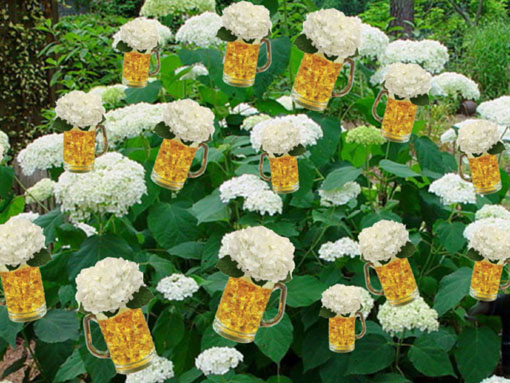
Imagine a Beer Hydrangea bearing frosty mugs of ice cold, frothy beer, ready for Dad to pluck off and enjoy on a hot summer afternoon.
This is a re-post from June 2012. Craft beers continue to be introduced and enjoyed by many. We wish all dads of legal drinking age a Happy Father’s Day.
 What better way to spend a Father’s Day than creating some good old home brewed beer with Dad! With home brewing all the rage and many home brewing retail locations opening, you can start a home brewing operation for under $200.00. Brewing beer is a very simple process that many do-it-yourselfers have grown to love. Northern Brewer, a home brewing supply company, states “If you can cook macaroni and cheese from a box you can brew beer.” Beer only consists of four major ingredients: water, malt, hops and yeast. Many home brewers find this hobby very rewarding, especially when enjoying the fruits of their labor. After a few batches many home brewers have gained experience and are constantly experimenting and attempting to improve their recipes. One fun and exciting way is to grow, harvest and use your own hops for brewing.
What better way to spend a Father’s Day than creating some good old home brewed beer with Dad! With home brewing all the rage and many home brewing retail locations opening, you can start a home brewing operation for under $200.00. Brewing beer is a very simple process that many do-it-yourselfers have grown to love. Northern Brewer, a home brewing supply company, states “If you can cook macaroni and cheese from a box you can brew beer.” Beer only consists of four major ingredients: water, malt, hops and yeast. Many home brewers find this hobby very rewarding, especially when enjoying the fruits of their labor. After a few batches many home brewers have gained experience and are constantly experimenting and attempting to improve their recipes. One fun and exciting way is to grow, harvest and use your own hops for brewing.
Nature’s Perspective is pleased to announce that we are now carrying a variety of hop vines available for installation. Growing hops is an exciting and fun way to add a new twist to your brew. Hops come in many varieties that can produce very different flavors and aromas. All hops are grown from a root-like cutting known as a rhizome. Hops grow in a vine form commonly known as bines. Hops grow in full sun, so southern exposure is ideal. They grow exceptionally fast and spread over 25’ in a season, and can weigh over 20lbs. It’s important to use a strong trellis or other structural support to ensure a bountiful crop. Hop cones are typically ripe and ready for harvest in late summer or early fall. Just one or two hop plants can produce a healthy yield that would satisfy any home brewer. After the hop cone is harvested, it is dried in a paper bag or on a screen and then weighed and measured. At this point you can decide to use the hops to brew or vacuum-seal them and put them in the freezer for proper storage for a later brewing date. At the end of the season the hop bines are typically cut back to 3 feet, and survive over the winter. Growing hops is a great way to add some green to your back yard and add a personal touch to your home brew. We currently have Chinook, Tettenger, Nugget, Cascade, Centennial, Mt. Hood, and Golden varieties of hops available. Supplies are limited, so if you are a home brewer and want to take the next step, give us a call.
Photos shown:
1) Hop bines beautifully grace an arbor. Talk about double duty!
2) Hop cones ready for the picking.
3) Paul harvests a bounty of hops… grown right on our premises!
4) Once dried, hops are ready for brewing, or can be stored frozen for later use.
